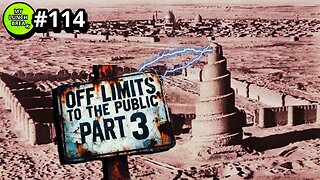Premium Only Content

Echoes of Many Gods: The Hidden Polytheistic Foundations of Judaism
The narrative we are often taught about Judaism, particularly in the context of the Old Testament, is that it is the world’s first and most enduring example of strict monotheism. The Hebrew people, we are told, were the first to conceive of and worship a single, all-powerful God, in stark contrast to the polytheistic traditions that surrounded them in the ancient world. However, as with many aspects of history and religion, this widely accepted narrative may not fully capture the complexities of the past. A deeper exploration reveals a far more nuanced and eclectic religious tradition that has evolved over millennia, drawing on a rich tapestry of influences from various cultures and belief systems.
#### **I. The Polytheistic Roots of Ancient Judaism**
To understand the polytheistic foundations of Judaism, we must first look to the ancient Near East, where the Hebrews emerged as a distinct people. This region was a melting pot of cultures, each with its own pantheon of gods and goddesses. The Canaanites, for example, worshipped a diverse array of deities, including El, Baal, Asherah, and Anat. It is within this context that the early Hebrew religion developed, and it is likely that the Hebrews originally worshipped a similar pantheon.
The Hebrew Bible itself offers evidence of this polytheistic past. The name "El," one of the oldest names for God in the Bible, was originally the name of the chief god of the Canaanite pantheon. Other references in the Bible suggest that the early Hebrews worshipped multiple deities before the idea of monotheism became dominant. For instance, the use of the plural form "Elohim" in Genesis is often cited as an indication of an earlier belief in multiple gods. Although "Elohim" is typically translated as "God" in a monotheistic context, its original use likely referred to a council of gods, a common motif in ancient Near Eastern religions.
Furthermore, archaeological discoveries have unearthed evidence of the worship of Asherah, a mother goddess who was venerated alongside Yahweh in some ancient Israelite communities. Inscriptions from sites like Kuntillet Ajrud and Khirbet el-Qom suggest that Yahweh had a consort, and that Asherah was revered as the "Queen of Heaven." This implies that the transition to monotheism was not a sudden or absolute shift, but rather a gradual process that involved the integration and suppression of earlier polytheistic traditions.
#### **II. The Evolution of Jewish Monotheism**
The journey from polytheism to monotheism in Judaism was neither linear nor straightforward. It was a complex evolution that involved the syncretism of various religious traditions and the reinterpretation of earlier beliefs. As the Hebrews interacted with neighboring cultures and were influenced by their religious practices, their own theology began to shift.
One significant turning point in this evolution was the Babylonian Exile in the 6th century BCE. During this period, the elite of Judah were deported to Babylon, where they were exposed to the rich religious traditions of the Mesopotamians. The experience of exile and the subsequent return to Jerusalem fostered a re-evaluation of the Hebrews' relationship with their God. It was during this time that the idea of Yahweh as the sole, universal God began to take root more firmly. The trauma of exile, combined with the need to preserve a distinct identity in a foreign land, likely contributed to the shift towards a more exclusive form of worship.
However, even as monotheism became more pronounced, traces of the earlier polytheistic beliefs remained embedded in Jewish thought. The biblical texts, which were written and compiled over centuries, reflect this complex theological evolution. For example, the Book of Psalms includes numerous references to other gods, even as it extols the supremacy of Yahweh. Similarly, the prophetic literature often speaks against the worship of foreign gods, indicating that such practices were still prevalent among the people.
#### **III. The Syncretic Nature of Jewish Theology**
Judaism, like many religious traditions, has always been syncretic—borrowing, adapting, and integrating elements from other cultures and religions. This eclectic nature is evident in the development of Jewish theology, which has incorporated ideas from a wide range of sources over the centuries.
The influence of Zoroastrianism, the ancient Persian religion, is one notable example. During the Persian period, when the Jewish people were under Persian rule, concepts such as dualism, angels, and the afterlife began to appear more prominently in Jewish thought. The Zoroastrian belief in a cosmic struggle between the forces of good and evil likely influenced the Jewish understanding of Satan as an adversary of God, a figure who does not appear prominently in earlier biblical texts.
Another significant influence came from Greek philosophy, particularly during the Hellenistic period following Alexander the Great’s conquests. Jewish thinkers such as Philo of Alexandria sought to harmonize Greek philosophical concepts with Jewish theology, leading to the development of ideas such as the Logos—a divine intermediary that would later be influential in Christian thought.
These examples illustrate how Judaism has continuously evolved by incorporating and reinterpreting the religious and philosophical ideas of the cultures with which it has come into contact. Far from being a static or purely monotheistic tradition, Judaism has always been a dynamic and eclectic faith, shaped by a diverse array of influences.
#### **IV. The Impact of Eclectic Theology on Modern Judaism**
The eclectic nature of Jewish theology has had a profound impact on the development of modern Judaism. Today, Judaism encompasses a wide spectrum of beliefs and practices, from the strict monotheism of Orthodox Judaism to the more pluralistic and inclusive approaches of Reform and Reconstructionist Judaism. This diversity reflects the religion’s long history of adaptation and integration.
In modern times, this eclecticism has allowed Judaism to engage with contemporary issues and ideas in ways that are both innovative and deeply rooted in tradition. Jewish mysticism, particularly the Kabbalistic tradition, continues to explore the complex nature of the divine, including the relationship between the One and the Many. The Qliphoth, as discussed in the context of Jewish mysticism, represent the shadow side of creation, further illustrating the nuanced and multifaceted nature of Jewish theology.
Moreover, the recognition of Judaism’s eclectic roots challenges the simplistic narratives that often dominate discussions of religion. It encourages a more nuanced understanding of how religious traditions develop and evolve, highlighting the ways in which they are shaped by historical, cultural, and philosophical influences.
#### **V. Confronting the Illusions: Toward a Deeper Understanding of the Divine**
The story of Judaism’s evolution from a polytheistic past to a more defined monotheism invites us to question our own understanding of the divine and the narratives we have been taught. It challenges us to consider the possibility that our conceptions of God and spirituality may be more complex and multifaceted than we have been led to believe.
As we confront these illusions and explore the deeper truths of our spiritual heritage, we are reminded that the divine cannot be fully contained within any single narrative or tradition. The eclectic nature of Judaism serves as a testament to the richness and diversity of human religious experience, offering a model for how we might approach our own spiritual journeys with openness and curiosity.
#### **Conclusion: Embracing the Complexity of Faith**
The hidden polytheistic foundations of Judaism reveal a tradition that is far more complex and dynamic than the simplistic narratives of monotheism suggest. By acknowledging and exploring these roots, we gain a deeper appreciation for the richness of Jewish theology and the ways in which it has been shaped by a multitude of influences over millennia.
This exploration invites us to embrace the complexity of faith, recognizing that religious traditions are not static but are continually evolving. It challenges us to look beyond the surface and seek a deeper understanding of the divine, one that honors the diversity and interconnectedness of all spiritual paths. In doing so, we may find that the echoes of many gods still resonate within us, guiding us toward a more profound and inclusive understanding of the sacred.
-
 1:26
1:26
FragmentsOfTruth
3 days agoJFK’s Battle Against the New World Order: The Untold Economic Revolution
1571 -
 LIVE
LIVE
Vocalot
13 hours agoDay 6! New Here! New Rumble Friends!? 🤙
1,424 watching -
 LIVE
LIVE
Mally_Mouse
2 hours agoSaturday Shenanigans!! - Let's Play: Mario Party Jamboree
701 watching -
 1:13:00
1:13:00
Patriots With Grit
6 hours agoWill Americans Rise Up? | Jeff Calhoun
3.68K3 -
 14:55
14:55
Exploring With Nug
6 hours ago $4.52 earnedWe Found Semi Truck Containers While Searching for Missing Man!
25.3K4 -
 27:57
27:57
MYLUNCHBREAK CHANNEL PAGE
13 hours agoOff Limits to the Public - Pt 3
47.7K49 -
 38:07
38:07
Michael Franzese
6 hours agoLeaving Organized Crime and Uncovering Mob in Politics: Tudor Dixon and Michael Franzese
41.2K13 -
 2:42:54
2:42:54
Jewels Jones Live ®
1 day agoAMERICA IS BACK | A Political Rendezvous - Ep. 111
39.1K39 -

Due Dissidence
1 day agoLIVE: Workers Strike Back Conference ft. Chris Hedges, Jill Stein, Kshama Sawant, and More!
81K50 -
 8:36:37
8:36:37
Right Side Broadcasting Network
5 days agoLIVE REPLAY: CPAC 2025 Day Three with President Donald J. Trump - 2/22/25
389K93